Education Support: Aboriginal Cultural Safety Formative Assessment
VerifiedAdded on 2021/02/22
|30
|7212
|347
Homework Assignment
AI Summary
This assignment addresses Aboriginal cultural safety within healthcare settings, focusing on the identification of cultural factors impacting service delivery to Aboriginal clients. It explores the importance of cultural awareness, sensitivity, and competence, and how these elements influence communication and relationships. The assignment highlights issues affecting communication, such as lack of culturally relevant education and employment opportunities, and emphasizes the need to identify these factors when designing and delivering services. It explains cultural safety, its importance in the relationship between service providers and indigenous communities, and how it can be integrated into the workplace. Additionally, it covers how to ensure work practices are grounded in awareness of cultural bias, defines cultural competence, and explores communication techniques and work practices that show respect for cultural differences. Finally, it discusses the benefits of engaging Aboriginal community service workers, interpreters, and cultural brokers to improve healthcare outcomes.
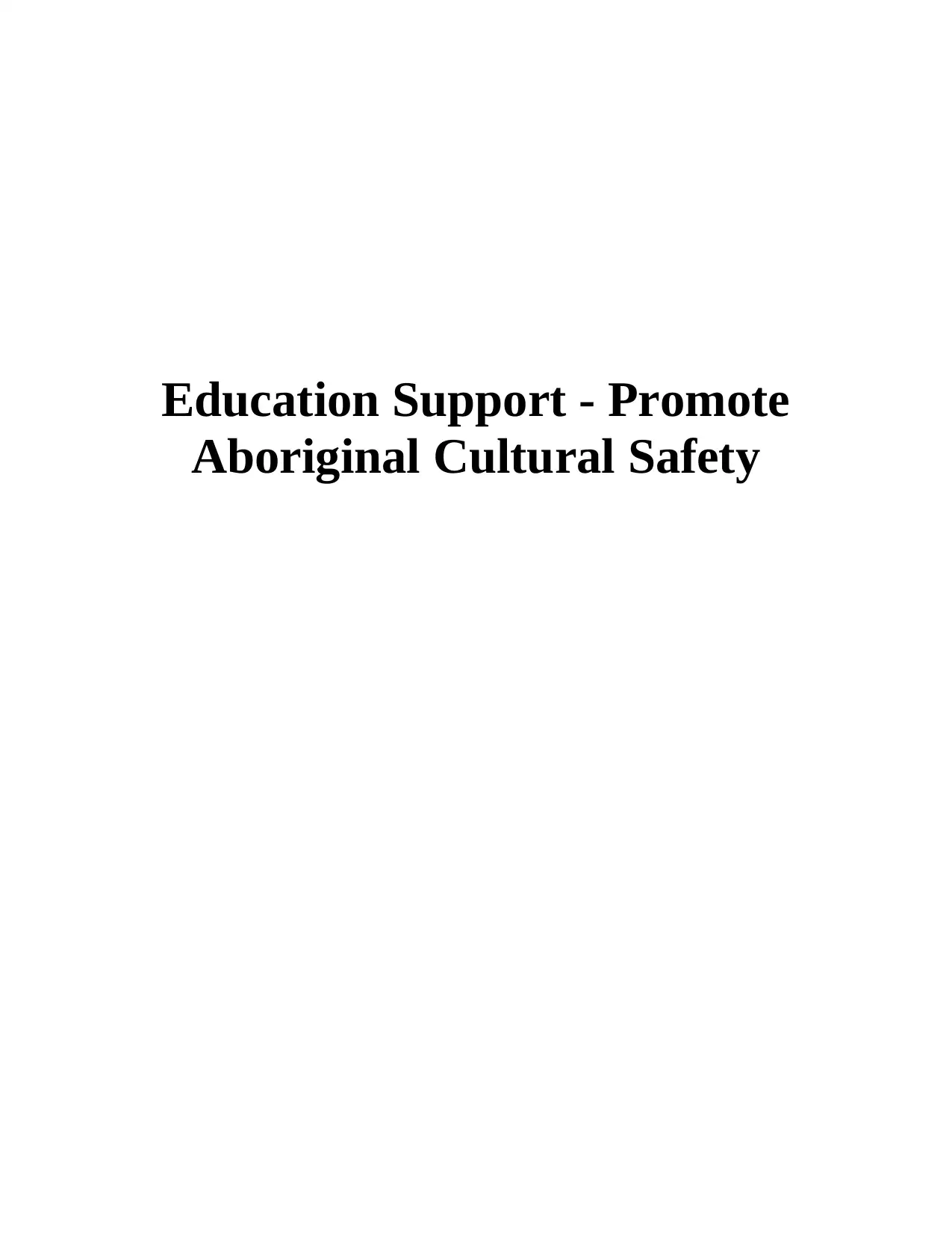
Education Support - Promote
Aboriginal Cultural Safety
Aboriginal Cultural Safety
Paraphrase This Document
Need a fresh take? Get an instant paraphrase of this document with our AI Paraphraser
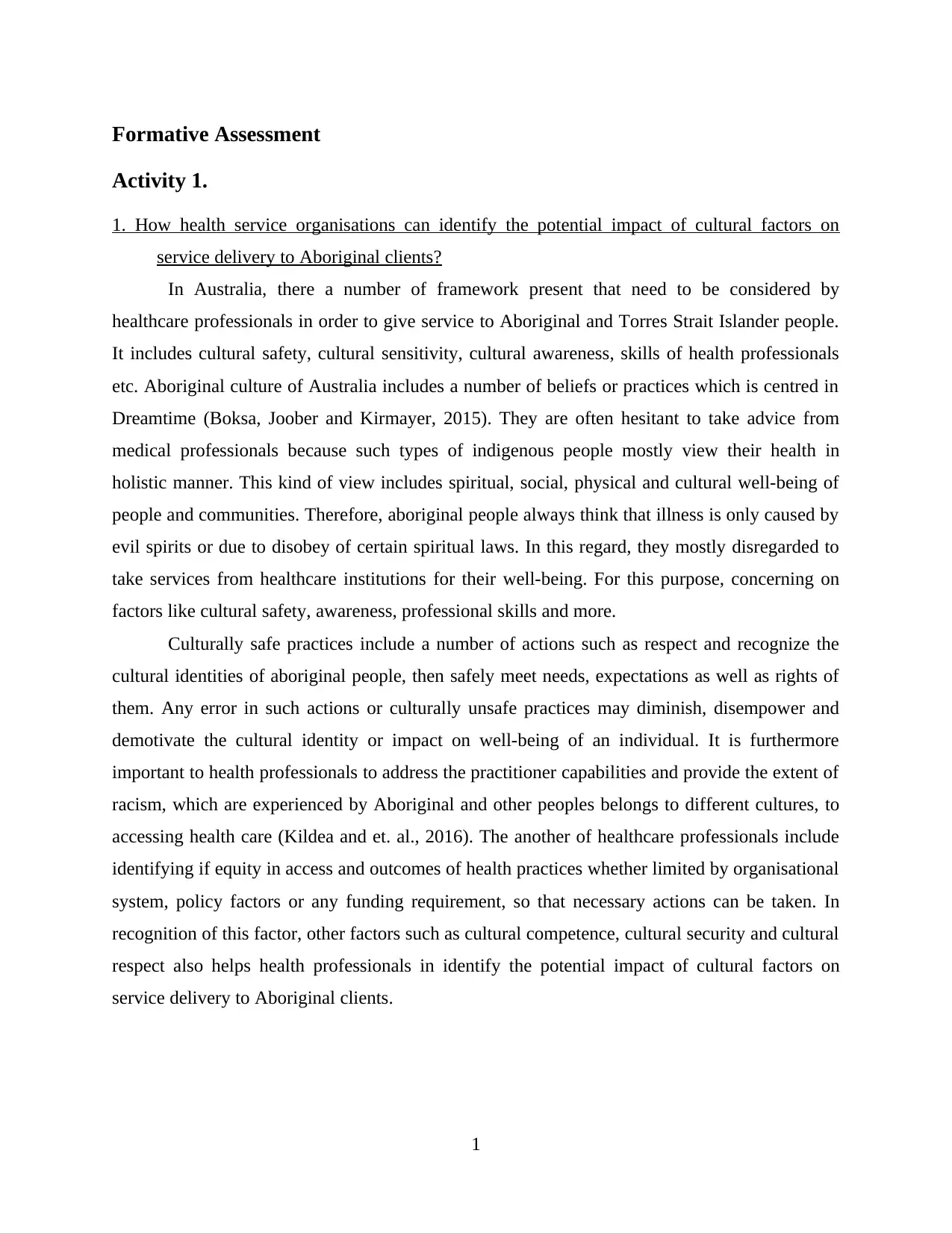
Formative Assessment
Activity 1.
1. How health service organisations can identify the potential impact of cultural factors on
service delivery to Aboriginal clients?
In Australia, there a number of framework present that need to be considered by
healthcare professionals in order to give service to Aboriginal and Torres Strait Islander people.
It includes cultural safety, cultural sensitivity, cultural awareness, skills of health professionals
etc. Aboriginal culture of Australia includes a number of beliefs or practices which is centred in
Dreamtime (Boksa, Joober and Kirmayer, 2015). They are often hesitant to take advice from
medical professionals because such types of indigenous people mostly view their health in
holistic manner. This kind of view includes spiritual, social, physical and cultural well-being of
people and communities. Therefore, aboriginal people always think that illness is only caused by
evil spirits or due to disobey of certain spiritual laws. In this regard, they mostly disregarded to
take services from healthcare institutions for their well-being. For this purpose, concerning on
factors like cultural safety, awareness, professional skills and more.
Culturally safe practices include a number of actions such as respect and recognize the
cultural identities of aboriginal people, then safely meet needs, expectations as well as rights of
them. Any error in such actions or culturally unsafe practices may diminish, disempower and
demotivate the cultural identity or impact on well-being of an individual. It is furthermore
important to health professionals to address the practitioner capabilities and provide the extent of
racism, which are experienced by Aboriginal and other peoples belongs to different cultures, to
accessing health care (Kildea and et. al., 2016). The another of healthcare professionals include
identifying if equity in access and outcomes of health practices whether limited by organisational
system, policy factors or any funding requirement, so that necessary actions can be taken. In
recognition of this factor, other factors such as cultural competence, cultural security and cultural
respect also helps health professionals in identify the potential impact of cultural factors on
service delivery to Aboriginal clients.
1
Activity 1.
1. How health service organisations can identify the potential impact of cultural factors on
service delivery to Aboriginal clients?
In Australia, there a number of framework present that need to be considered by
healthcare professionals in order to give service to Aboriginal and Torres Strait Islander people.
It includes cultural safety, cultural sensitivity, cultural awareness, skills of health professionals
etc. Aboriginal culture of Australia includes a number of beliefs or practices which is centred in
Dreamtime (Boksa, Joober and Kirmayer, 2015). They are often hesitant to take advice from
medical professionals because such types of indigenous people mostly view their health in
holistic manner. This kind of view includes spiritual, social, physical and cultural well-being of
people and communities. Therefore, aboriginal people always think that illness is only caused by
evil spirits or due to disobey of certain spiritual laws. In this regard, they mostly disregarded to
take services from healthcare institutions for their well-being. For this purpose, concerning on
factors like cultural safety, awareness, professional skills and more.
Culturally safe practices include a number of actions such as respect and recognize the
cultural identities of aboriginal people, then safely meet needs, expectations as well as rights of
them. Any error in such actions or culturally unsafe practices may diminish, disempower and
demotivate the cultural identity or impact on well-being of an individual. It is furthermore
important to health professionals to address the practitioner capabilities and provide the extent of
racism, which are experienced by Aboriginal and other peoples belongs to different cultures, to
accessing health care (Kildea and et. al., 2016). The another of healthcare professionals include
identifying if equity in access and outcomes of health practices whether limited by organisational
system, policy factors or any funding requirement, so that necessary actions can be taken. In
recognition of this factor, other factors such as cultural competence, cultural security and cultural
respect also helps health professionals in identify the potential impact of cultural factors on
service delivery to Aboriginal clients.
1
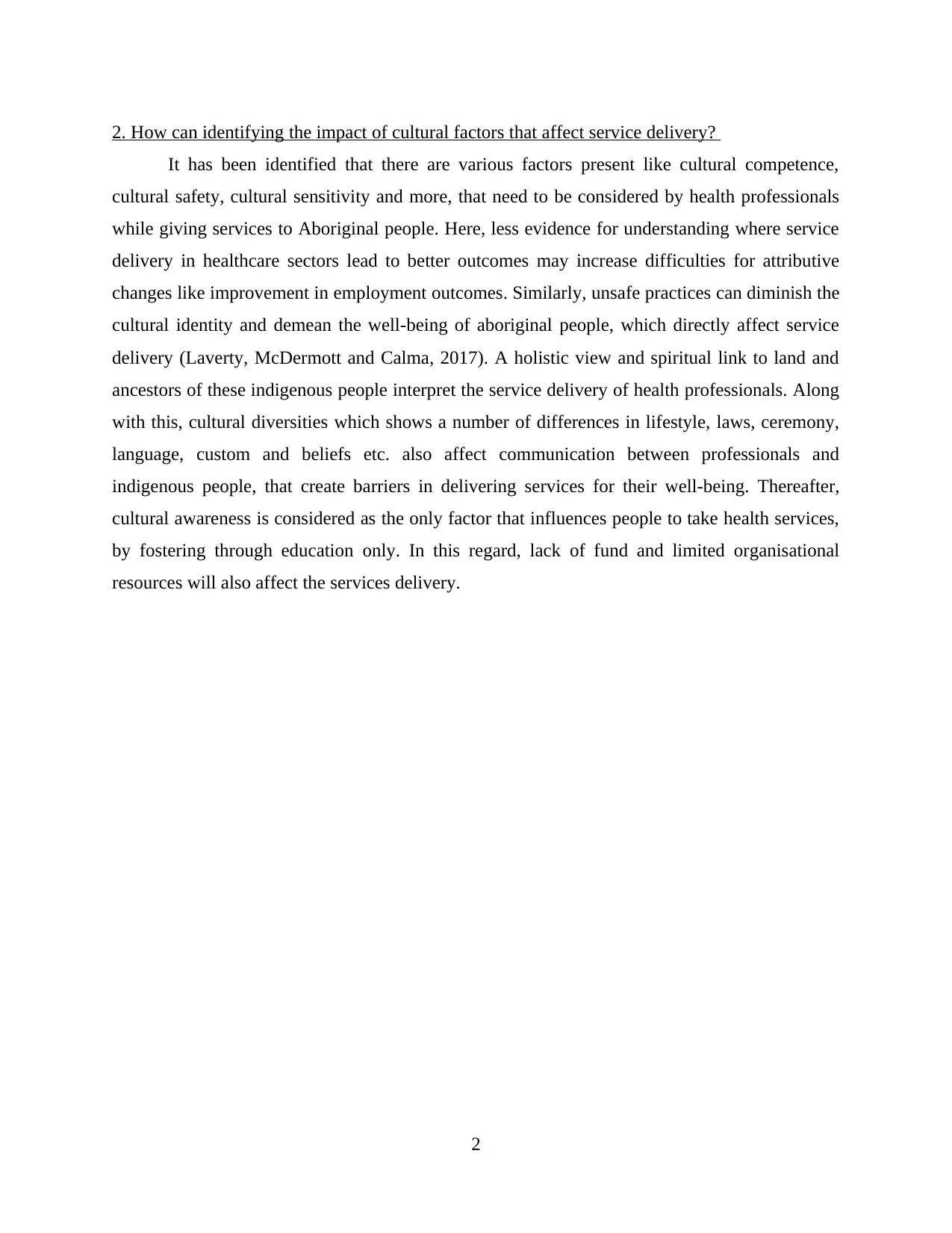
2. How can identifying the impact of cultural factors that affect service delivery?
It has been identified that there are various factors present like cultural competence,
cultural safety, cultural sensitivity and more, that need to be considered by health professionals
while giving services to Aboriginal people. Here, less evidence for understanding where service
delivery in healthcare sectors lead to better outcomes may increase difficulties for attributive
changes like improvement in employment outcomes. Similarly, unsafe practices can diminish the
cultural identity and demean the well-being of aboriginal people, which directly affect service
delivery (Laverty, McDermott and Calma, 2017). A holistic view and spiritual link to land and
ancestors of these indigenous people interpret the service delivery of health professionals. Along
with this, cultural diversities which shows a number of differences in lifestyle, laws, ceremony,
language, custom and beliefs etc. also affect communication between professionals and
indigenous people, that create barriers in delivering services for their well-being. Thereafter,
cultural awareness is considered as the only factor that influences people to take health services,
by fostering through education only. In this regard, lack of fund and limited organisational
resources will also affect the services delivery.
2
It has been identified that there are various factors present like cultural competence,
cultural safety, cultural sensitivity and more, that need to be considered by health professionals
while giving services to Aboriginal people. Here, less evidence for understanding where service
delivery in healthcare sectors lead to better outcomes may increase difficulties for attributive
changes like improvement in employment outcomes. Similarly, unsafe practices can diminish the
cultural identity and demean the well-being of aboriginal people, which directly affect service
delivery (Laverty, McDermott and Calma, 2017). A holistic view and spiritual link to land and
ancestors of these indigenous people interpret the service delivery of health professionals. Along
with this, cultural diversities which shows a number of differences in lifestyle, laws, ceremony,
language, custom and beliefs etc. also affect communication between professionals and
indigenous people, that create barriers in delivering services for their well-being. Thereafter,
cultural awareness is considered as the only factor that influences people to take health services,
by fostering through education only. In this regard, lack of fund and limited organisational
resources will also affect the services delivery.
2
⊘ This is a preview!⊘
Do you want full access?
Subscribe today to unlock all pages.

Trusted by 1+ million students worldwide
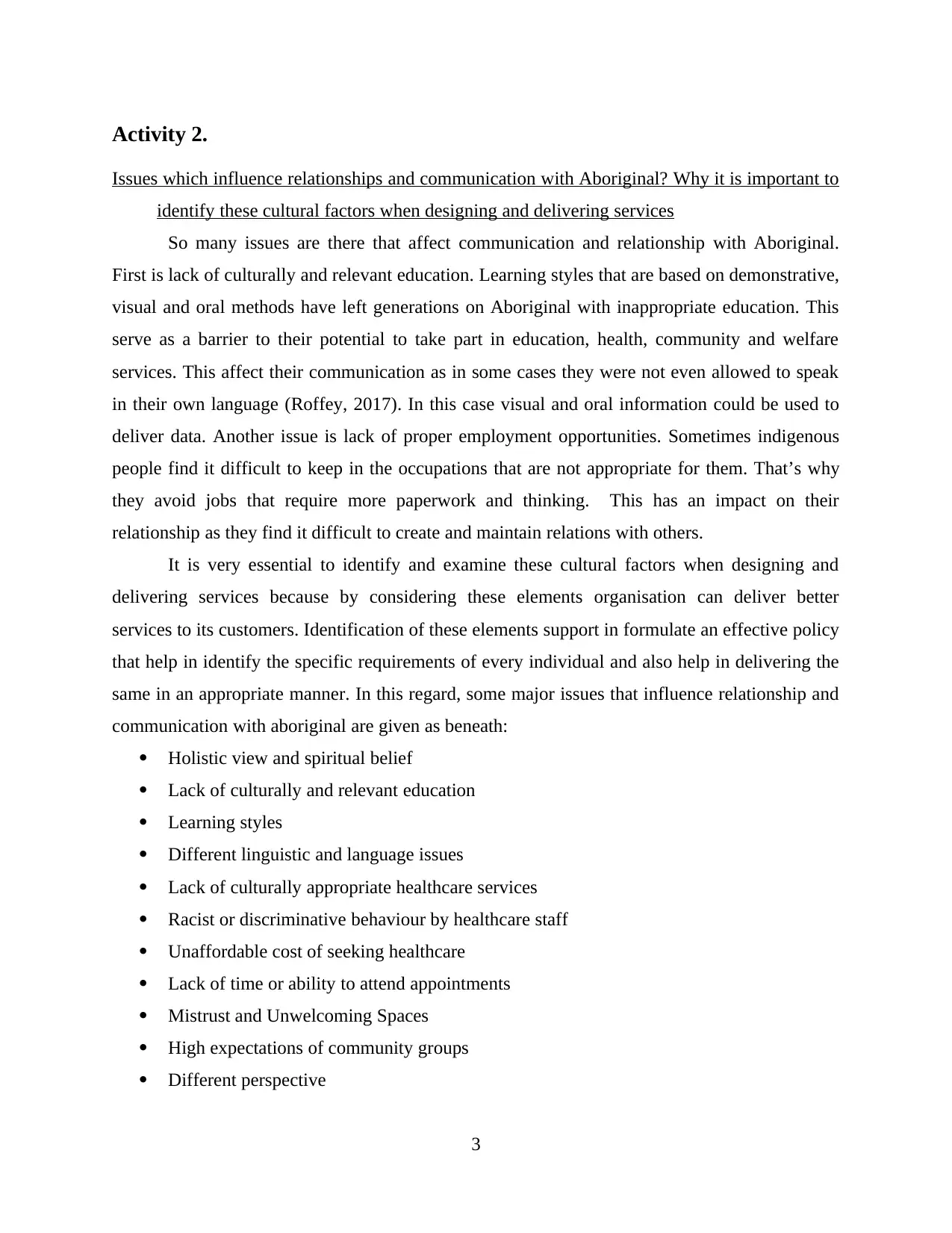
Activity 2.
Issues which influence relationships and communication with Aboriginal? Why it is important to
identify these cultural factors when designing and delivering services
So many issues are there that affect communication and relationship with Aboriginal.
First is lack of culturally and relevant education. Learning styles that are based on demonstrative,
visual and oral methods have left generations on Aboriginal with inappropriate education. This
serve as a barrier to their potential to take part in education, health, community and welfare
services. This affect their communication as in some cases they were not even allowed to speak
in their own language (Roffey, 2017). In this case visual and oral information could be used to
deliver data. Another issue is lack of proper employment opportunities. Sometimes indigenous
people find it difficult to keep in the occupations that are not appropriate for them. That’s why
they avoid jobs that require more paperwork and thinking. This has an impact on their
relationship as they find it difficult to create and maintain relations with others.
It is very essential to identify and examine these cultural factors when designing and
delivering services because by considering these elements organisation can deliver better
services to its customers. Identification of these elements support in formulate an effective policy
that help in identify the specific requirements of every individual and also help in delivering the
same in an appropriate manner. In this regard, some major issues that influence relationship and
communication with aboriginal are given as beneath:
Holistic view and spiritual belief
Lack of culturally and relevant education
Learning styles
Different linguistic and language issues
Lack of culturally appropriate healthcare services
Racist or discriminative behaviour by healthcare staff
Unaffordable cost of seeking healthcare
Lack of time or ability to attend appointments
Mistrust and Unwelcoming Spaces
High expectations of community groups
Different perspective
3
Issues which influence relationships and communication with Aboriginal? Why it is important to
identify these cultural factors when designing and delivering services
So many issues are there that affect communication and relationship with Aboriginal.
First is lack of culturally and relevant education. Learning styles that are based on demonstrative,
visual and oral methods have left generations on Aboriginal with inappropriate education. This
serve as a barrier to their potential to take part in education, health, community and welfare
services. This affect their communication as in some cases they were not even allowed to speak
in their own language (Roffey, 2017). In this case visual and oral information could be used to
deliver data. Another issue is lack of proper employment opportunities. Sometimes indigenous
people find it difficult to keep in the occupations that are not appropriate for them. That’s why
they avoid jobs that require more paperwork and thinking. This has an impact on their
relationship as they find it difficult to create and maintain relations with others.
It is very essential to identify and examine these cultural factors when designing and
delivering services because by considering these elements organisation can deliver better
services to its customers. Identification of these elements support in formulate an effective policy
that help in identify the specific requirements of every individual and also help in delivering the
same in an appropriate manner. In this regard, some major issues that influence relationship and
communication with aboriginal are given as beneath:
Holistic view and spiritual belief
Lack of culturally and relevant education
Learning styles
Different linguistic and language issues
Lack of culturally appropriate healthcare services
Racist or discriminative behaviour by healthcare staff
Unaffordable cost of seeking healthcare
Lack of time or ability to attend appointments
Mistrust and Unwelcoming Spaces
High expectations of community groups
Different perspective
3
Paraphrase This Document
Need a fresh take? Get an instant paraphrase of this document with our AI Paraphraser
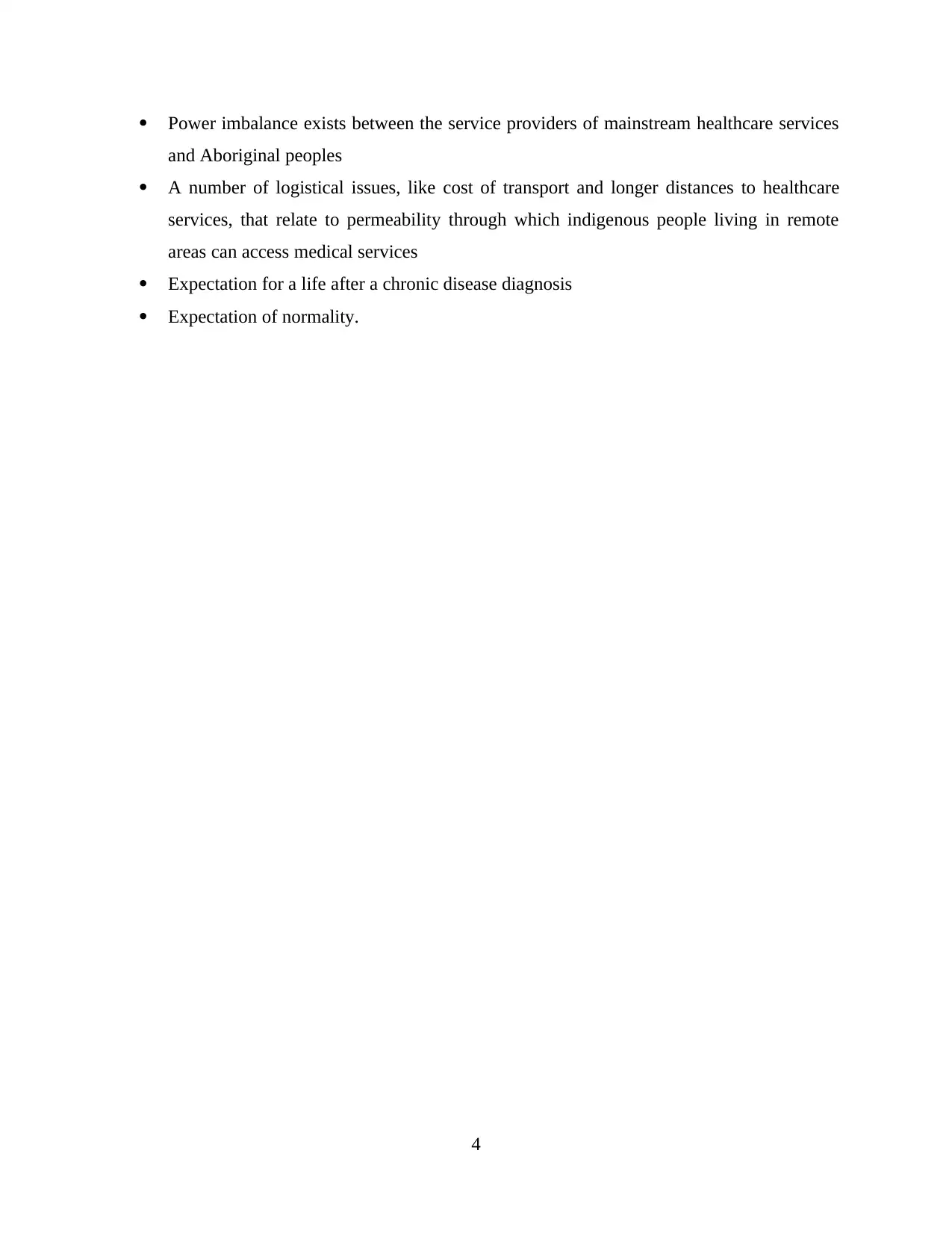
Power imbalance exists between the service providers of mainstream healthcare services
and Aboriginal peoples
A number of logistical issues, like cost of transport and longer distances to healthcare
services, that relate to permeability through which indigenous people living in remote
areas can access medical services
Expectation for a life after a chronic disease diagnosis
Expectation of normality.
4
and Aboriginal peoples
A number of logistical issues, like cost of transport and longer distances to healthcare
services, that relate to permeability through which indigenous people living in remote
areas can access medical services
Expectation for a life after a chronic disease diagnosis
Expectation of normality.
4

Activity 3.
To establish the key aspects of cultural safety it will be necessary to consult with indigenous co-
workers, community members and elders. Explain cultural safety, its importance to
relationship between service providers and indigenous communities and how it can be
integrated into workplace
Cultural safety refers to concept which emerged in the late 1980s and creates a
framework for service delivery related to appropriate health services for the people, especially
belongs to Aboriginal, Torres Strait Islander people, Maori and more. Recognising this concept
help professionals in health care settings and developing affective relationship with indigenous
people, in delivering services for their well-being. In order to develop the positive relationship
between service providers and indigenous people, it is essential for healthcare organisations to
concern on some important principle of cultural safety. It includes rather than to ask individuals
to focus on cultural dimensions of other cultures, concerns on own cultural identities and
attitudes first (Clifford and et. al., 2015). Hereby, being open-minded as well as flexible in
attitudes towards culture of others, identifying what makes others, understanding own culture
and its influence on own belief etc. help in recognising the culture safety while delivering
services. These principles can be incorporated at workplace within healthcare service
organisations by – Developing trust and proper communication; Clear, free, open-minded and
respectful communication; Understanding other cultures and their influence.
Furthermore, the process towards becoming culturally safe also includes three main key
elements that cultural awareness, cultural sensitivity and cultural safety. All these processes need
to be achieved for health service providers in order to be in a position for negotiating culturally
safe interactions with others. By understanding own culture as well as the concept of transferring
of power among dominant and less dominant groups at workplace, make professionals culturally
safe in a number of contexts. It includes developing trust with indigenous people, actively
negotiate knowledge and outcomes via bi-cultural relationship with others. Here, cultural
awareness is considered as beginning step for understanding the difference between own culture
and culture of indigenous people, in order to recognise the basic needs of them. For this purpose,
it is essential to for health professionals to consult with other indigenous co-workers, elders and
5
To establish the key aspects of cultural safety it will be necessary to consult with indigenous co-
workers, community members and elders. Explain cultural safety, its importance to
relationship between service providers and indigenous communities and how it can be
integrated into workplace
Cultural safety refers to concept which emerged in the late 1980s and creates a
framework for service delivery related to appropriate health services for the people, especially
belongs to Aboriginal, Torres Strait Islander people, Maori and more. Recognising this concept
help professionals in health care settings and developing affective relationship with indigenous
people, in delivering services for their well-being. In order to develop the positive relationship
between service providers and indigenous people, it is essential for healthcare organisations to
concern on some important principle of cultural safety. It includes rather than to ask individuals
to focus on cultural dimensions of other cultures, concerns on own cultural identities and
attitudes first (Clifford and et. al., 2015). Hereby, being open-minded as well as flexible in
attitudes towards culture of others, identifying what makes others, understanding own culture
and its influence on own belief etc. help in recognising the culture safety while delivering
services. These principles can be incorporated at workplace within healthcare service
organisations by – Developing trust and proper communication; Clear, free, open-minded and
respectful communication; Understanding other cultures and their influence.
Furthermore, the process towards becoming culturally safe also includes three main key
elements that cultural awareness, cultural sensitivity and cultural safety. All these processes need
to be achieved for health service providers in order to be in a position for negotiating culturally
safe interactions with others. By understanding own culture as well as the concept of transferring
of power among dominant and less dominant groups at workplace, make professionals culturally
safe in a number of contexts. It includes developing trust with indigenous people, actively
negotiate knowledge and outcomes via bi-cultural relationship with others. Here, cultural
awareness is considered as beginning step for understanding the difference between own culture
and culture of indigenous people, in order to recognise the basic needs of them. For this purpose,
it is essential to for health professionals to consult with other indigenous co-workers, elders and
5
⊘ This is a preview!⊘
Do you want full access?
Subscribe today to unlock all pages.

Trusted by 1+ million students worldwide
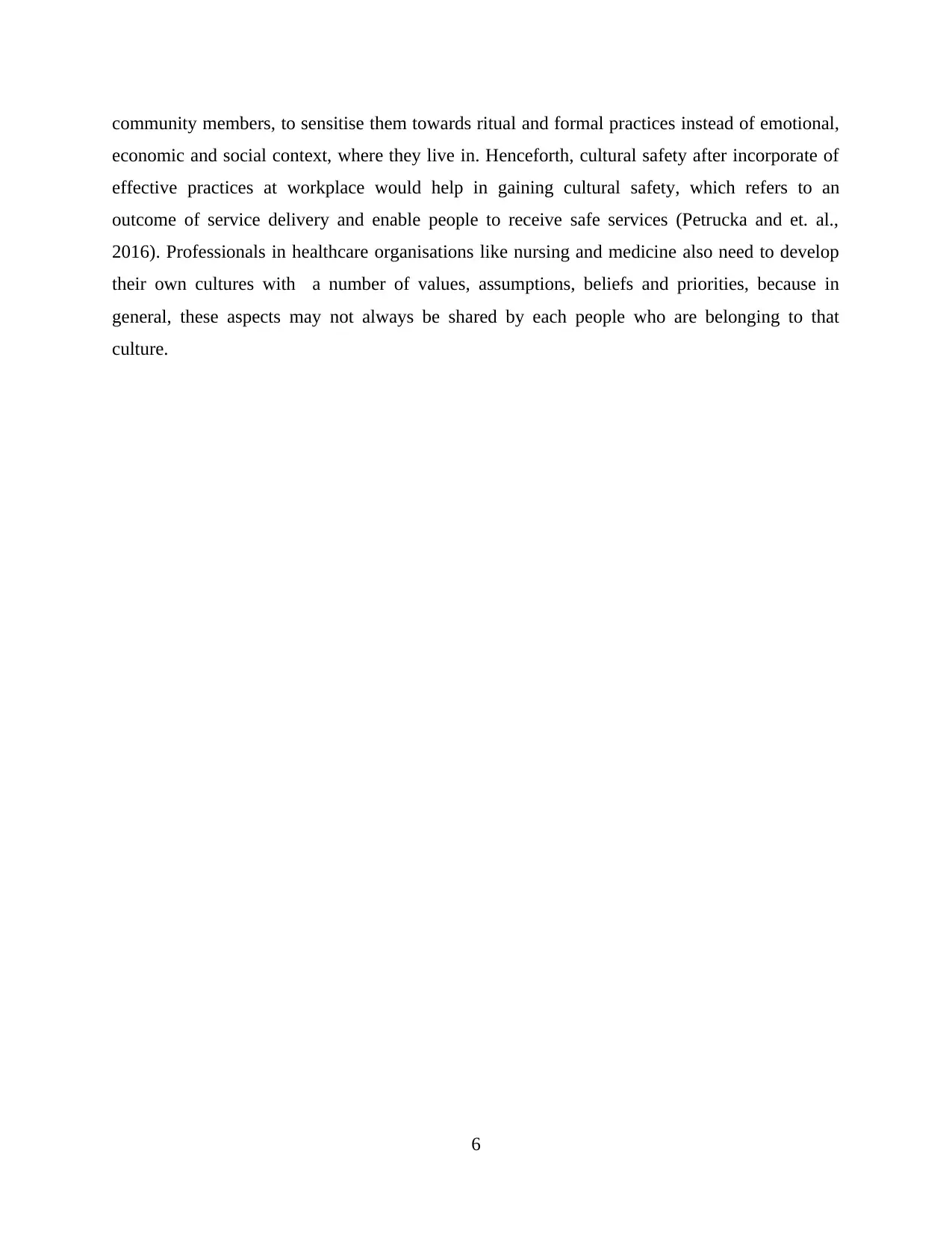
community members, to sensitise them towards ritual and formal practices instead of emotional,
economic and social context, where they live in. Henceforth, cultural safety after incorporate of
effective practices at workplace would help in gaining cultural safety, which refers to an
outcome of service delivery and enable people to receive safe services (Petrucka and et. al.,
2016). Professionals in healthcare organisations like nursing and medicine also need to develop
their own cultures with a number of values, assumptions, beliefs and priorities, because in
general, these aspects may not always be shared by each people who are belonging to that
culture.
6
economic and social context, where they live in. Henceforth, cultural safety after incorporate of
effective practices at workplace would help in gaining cultural safety, which refers to an
outcome of service delivery and enable people to receive safe services (Petrucka and et. al.,
2016). Professionals in healthcare organisations like nursing and medicine also need to develop
their own cultures with a number of values, assumptions, beliefs and priorities, because in
general, these aspects may not always be shared by each people who are belonging to that
culture.
6
Paraphrase This Document
Need a fresh take? Get an instant paraphrase of this document with our AI Paraphraser
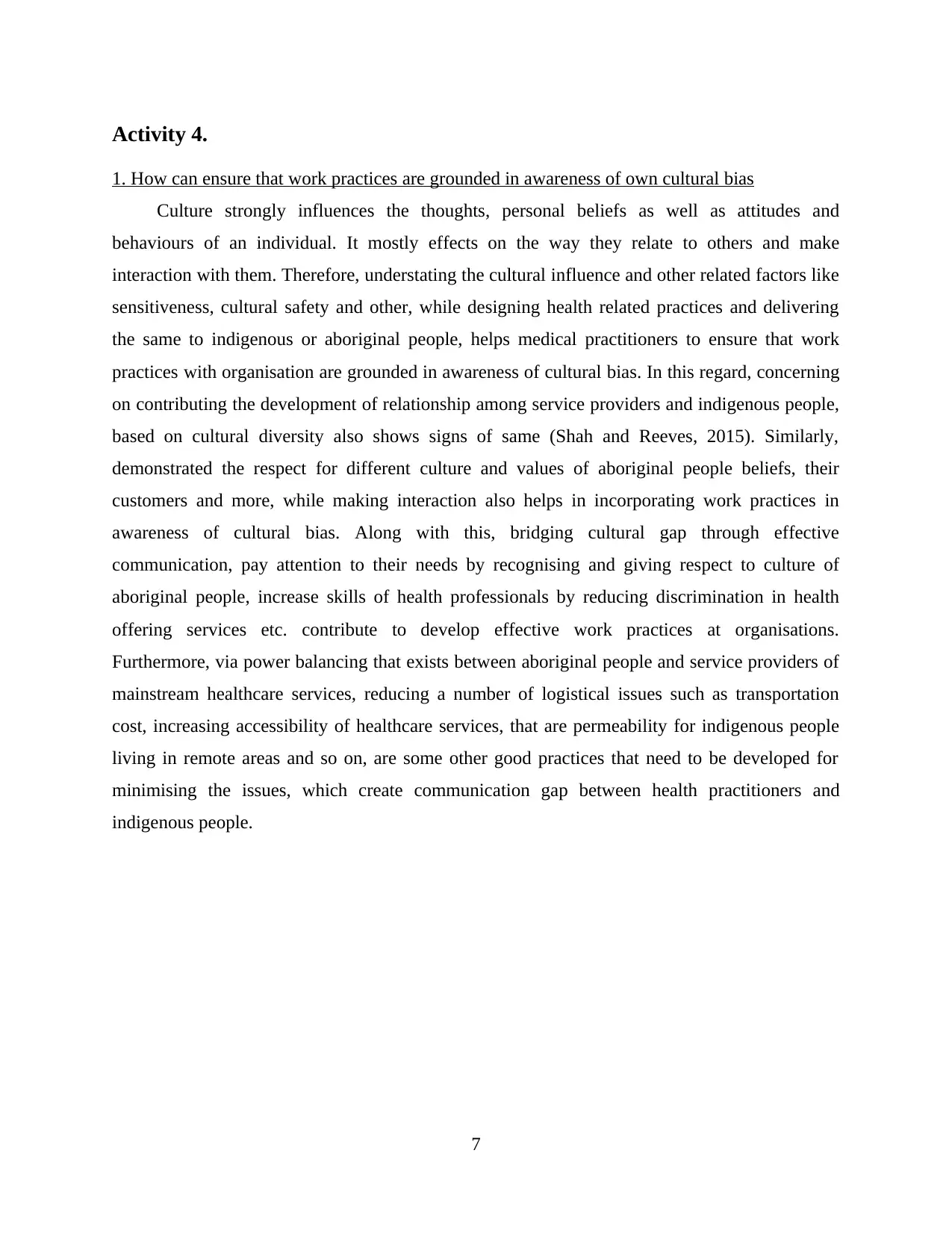
Activity 4.
1. How can ensure that work practices are grounded in awareness of own cultural bias
Culture strongly influences the thoughts, personal beliefs as well as attitudes and
behaviours of an individual. It mostly effects on the way they relate to others and make
interaction with them. Therefore, understating the cultural influence and other related factors like
sensitiveness, cultural safety and other, while designing health related practices and delivering
the same to indigenous or aboriginal people, helps medical practitioners to ensure that work
practices with organisation are grounded in awareness of cultural bias. In this regard, concerning
on contributing the development of relationship among service providers and indigenous people,
based on cultural diversity also shows signs of same (Shah and Reeves, 2015). Similarly,
demonstrated the respect for different culture and values of aboriginal people beliefs, their
customers and more, while making interaction also helps in incorporating work practices in
awareness of cultural bias. Along with this, bridging cultural gap through effective
communication, pay attention to their needs by recognising and giving respect to culture of
aboriginal people, increase skills of health professionals by reducing discrimination in health
offering services etc. contribute to develop effective work practices at organisations.
Furthermore, via power balancing that exists between aboriginal people and service providers of
mainstream healthcare services, reducing a number of logistical issues such as transportation
cost, increasing accessibility of healthcare services, that are permeability for indigenous people
living in remote areas and so on, are some other good practices that need to be developed for
minimising the issues, which create communication gap between health practitioners and
indigenous people.
7
1. How can ensure that work practices are grounded in awareness of own cultural bias
Culture strongly influences the thoughts, personal beliefs as well as attitudes and
behaviours of an individual. It mostly effects on the way they relate to others and make
interaction with them. Therefore, understating the cultural influence and other related factors like
sensitiveness, cultural safety and other, while designing health related practices and delivering
the same to indigenous or aboriginal people, helps medical practitioners to ensure that work
practices with organisation are grounded in awareness of cultural bias. In this regard, concerning
on contributing the development of relationship among service providers and indigenous people,
based on cultural diversity also shows signs of same (Shah and Reeves, 2015). Similarly,
demonstrated the respect for different culture and values of aboriginal people beliefs, their
customers and more, while making interaction also helps in incorporating work practices in
awareness of cultural bias. Along with this, bridging cultural gap through effective
communication, pay attention to their needs by recognising and giving respect to culture of
aboriginal people, increase skills of health professionals by reducing discrimination in health
offering services etc. contribute to develop effective work practices at organisations.
Furthermore, via power balancing that exists between aboriginal people and service providers of
mainstream healthcare services, reducing a number of logistical issues such as transportation
cost, increasing accessibility of healthcare services, that are permeability for indigenous people
living in remote areas and so on, are some other good practices that need to be developed for
minimising the issues, which create communication gap between health practitioners and
indigenous people.
7
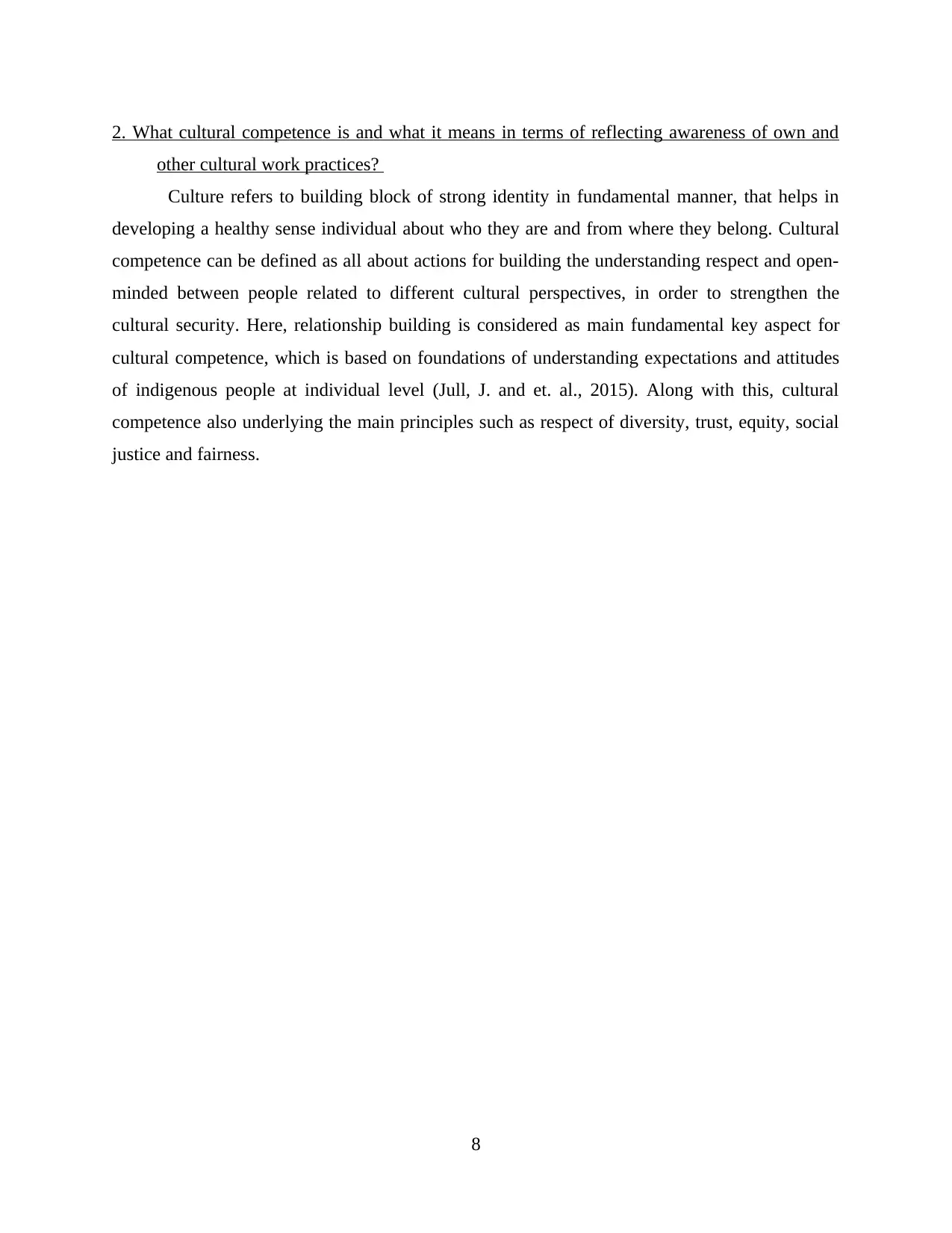
2. What cultural competence is and what it means in terms of reflecting awareness of own and
other cultural work practices?
Culture refers to building block of strong identity in fundamental manner, that helps in
developing a healthy sense individual about who they are and from where they belong. Cultural
competence can be defined as all about actions for building the understanding respect and open-
minded between people related to different cultural perspectives, in order to strengthen the
cultural security. Here, relationship building is considered as main fundamental key aspect for
cultural competence, which is based on foundations of understanding expectations and attitudes
of indigenous people at individual level (Jull, J. and et. al., 2015). Along with this, cultural
competence also underlying the main principles such as respect of diversity, trust, equity, social
justice and fairness.
8
other cultural work practices?
Culture refers to building block of strong identity in fundamental manner, that helps in
developing a healthy sense individual about who they are and from where they belong. Cultural
competence can be defined as all about actions for building the understanding respect and open-
minded between people related to different cultural perspectives, in order to strengthen the
cultural security. Here, relationship building is considered as main fundamental key aspect for
cultural competence, which is based on foundations of understanding expectations and attitudes
of indigenous people at individual level (Jull, J. and et. al., 2015). Along with this, cultural
competence also underlying the main principles such as respect of diversity, trust, equity, social
justice and fairness.
8
⊘ This is a preview!⊘
Do you want full access?
Subscribe today to unlock all pages.

Trusted by 1+ million students worldwide

Activity 5.
How communication techniques and work practices can be developed which show respect for
cultural difference of Aboriginal people?
In order to recognise and show respect for cultural difference of aboriginal people, there are
various ways through which health service organisation can develop effective work practices and
communication techniques. In includes concern on developing personal awareness to understand
a culture belief system, which helps in making effective communication with aboriginal people.
Similarly, to anticipate cultural belief it is essential for health professionals to recognise and
accept behaviours of others. Furthermore, pay attention to both verbal and non-verbal
communication also lead to design effective work practices for understanding the needs of
aboriginal people for offering effective health services. Hereby, working with interpreters who
are trained for handling both linguistic and cultural difference, helps in developing effective
interaction between service providers and aboriginal people (Andersen, Edwards and Wolfe,
2017). In addition to this, as communicating in a culturally appropriate way also helps health
service providers in finding a way for interacting effectively, which is essential for respects and
accepts cultural differences. For this purpose, take initiatives by making communication and
engaging with community members also helps in developing effective practices to recognise
culture of others by service providers.
9
How communication techniques and work practices can be developed which show respect for
cultural difference of Aboriginal people?
In order to recognise and show respect for cultural difference of aboriginal people, there are
various ways through which health service organisation can develop effective work practices and
communication techniques. In includes concern on developing personal awareness to understand
a culture belief system, which helps in making effective communication with aboriginal people.
Similarly, to anticipate cultural belief it is essential for health professionals to recognise and
accept behaviours of others. Furthermore, pay attention to both verbal and non-verbal
communication also lead to design effective work practices for understanding the needs of
aboriginal people for offering effective health services. Hereby, working with interpreters who
are trained for handling both linguistic and cultural difference, helps in developing effective
interaction between service providers and aboriginal people (Andersen, Edwards and Wolfe,
2017). In addition to this, as communicating in a culturally appropriate way also helps health
service providers in finding a way for interacting effectively, which is essential for respects and
accepts cultural differences. For this purpose, take initiatives by making communication and
engaging with community members also helps in developing effective practices to recognise
culture of others by service providers.
9
Paraphrase This Document
Need a fresh take? Get an instant paraphrase of this document with our AI Paraphraser
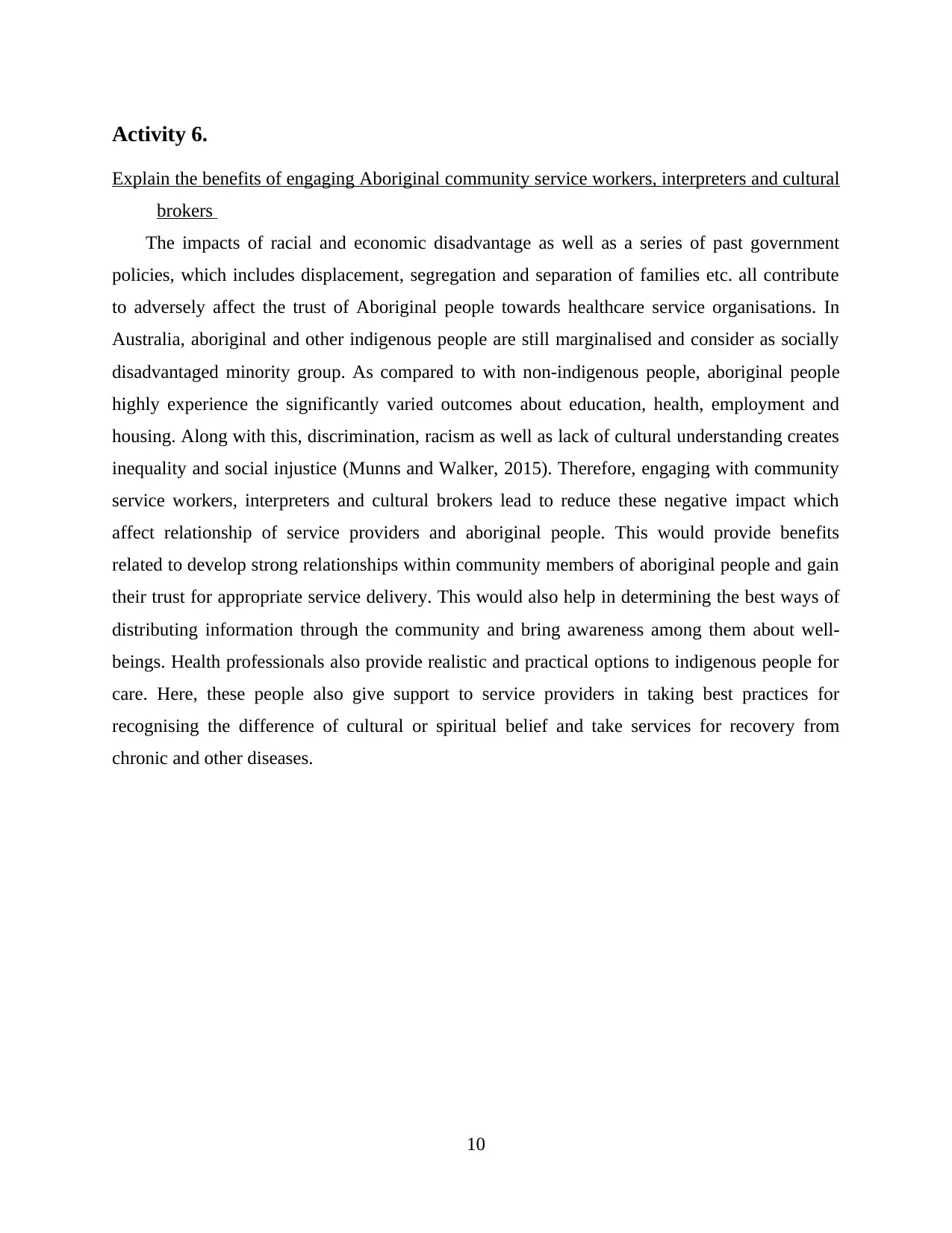
Activity 6.
Explain the benefits of engaging Aboriginal community service workers, interpreters and cultural
brokers
The impacts of racial and economic disadvantage as well as a series of past government
policies, which includes displacement, segregation and separation of families etc. all contribute
to adversely affect the trust of Aboriginal people towards healthcare service organisations. In
Australia, aboriginal and other indigenous people are still marginalised and consider as socially
disadvantaged minority group. As compared to with non-indigenous people, aboriginal people
highly experience the significantly varied outcomes about education, health, employment and
housing. Along with this, discrimination, racism as well as lack of cultural understanding creates
inequality and social injustice (Munns and Walker, 2015). Therefore, engaging with community
service workers, interpreters and cultural brokers lead to reduce these negative impact which
affect relationship of service providers and aboriginal people. This would provide benefits
related to develop strong relationships within community members of aboriginal people and gain
their trust for appropriate service delivery. This would also help in determining the best ways of
distributing information through the community and bring awareness among them about well-
beings. Health professionals also provide realistic and practical options to indigenous people for
care. Here, these people also give support to service providers in taking best practices for
recognising the difference of cultural or spiritual belief and take services for recovery from
chronic and other diseases.
10
Explain the benefits of engaging Aboriginal community service workers, interpreters and cultural
brokers
The impacts of racial and economic disadvantage as well as a series of past government
policies, which includes displacement, segregation and separation of families etc. all contribute
to adversely affect the trust of Aboriginal people towards healthcare service organisations. In
Australia, aboriginal and other indigenous people are still marginalised and consider as socially
disadvantaged minority group. As compared to with non-indigenous people, aboriginal people
highly experience the significantly varied outcomes about education, health, employment and
housing. Along with this, discrimination, racism as well as lack of cultural understanding creates
inequality and social injustice (Munns and Walker, 2015). Therefore, engaging with community
service workers, interpreters and cultural brokers lead to reduce these negative impact which
affect relationship of service providers and aboriginal people. This would provide benefits
related to develop strong relationships within community members of aboriginal people and gain
their trust for appropriate service delivery. This would also help in determining the best ways of
distributing information through the community and bring awareness among them about well-
beings. Health professionals also provide realistic and practical options to indigenous people for
care. Here, these people also give support to service providers in taking best practices for
recognising the difference of cultural or spiritual belief and take services for recovery from
chronic and other diseases.
10

Activity 7.
1. How it is possible to support the development of effective partnership between staff,
Aboriginal and their communities
In order to support the development of effective partnership between aboriginal people,
staff and their communities, organisations used to provide cultural competency training. It
includes Immigrant Women Support Service (IWSS), Queensland Program of Assistance to
Survivors of Torture and Trauma (QPASTT), Centre for Cultural Competence Australia and
more. Here, IWSS help in supporting the organisations for staff development and meeting their
specific needs for providing training to their staff. While QPASTT mainly aims to provide
training to people to minimise the issues related to refugee, impact of trauma and torture, reduce
gap skills and more, for staff and community development.
11
1. How it is possible to support the development of effective partnership between staff,
Aboriginal and their communities
In order to support the development of effective partnership between aboriginal people,
staff and their communities, organisations used to provide cultural competency training. It
includes Immigrant Women Support Service (IWSS), Queensland Program of Assistance to
Survivors of Torture and Trauma (QPASTT), Centre for Cultural Competence Australia and
more. Here, IWSS help in supporting the organisations for staff development and meeting their
specific needs for providing training to their staff. While QPASTT mainly aims to provide
training to people to minimise the issues related to refugee, impact of trauma and torture, reduce
gap skills and more, for staff and community development.
11
⊘ This is a preview!⊘
Do you want full access?
Subscribe today to unlock all pages.

Trusted by 1+ million students worldwide
1 out of 30
Related Documents
Your All-in-One AI-Powered Toolkit for Academic Success.
+13062052269
info@desklib.com
Available 24*7 on WhatsApp / Email
![[object Object]](/_next/static/media/star-bottom.7253800d.svg)
Unlock your academic potential
Copyright © 2020–2025 A2Z Services. All Rights Reserved. Developed and managed by ZUCOL.





